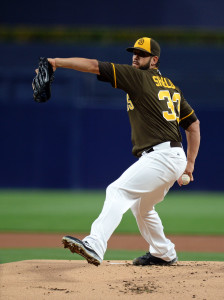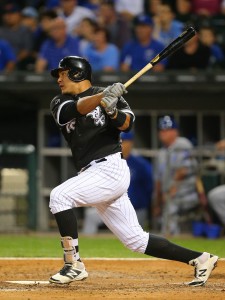You have to give the White Sox credit for signing Fernando Tatis Jr. in the first place. They snagged the 16-year-old as an international signing out of the Dominican Republic back in 2015 for a bonus of $700K, years after Marco Paddy had restored credibility to the team’s efforts in Latin America following the David Wilder scandal.
At the time, MLB.com ranked Tatis Jr. 30th in his class, which also included Vladimir Guerrero Jr., Juan Soto, and Cristian Pache. The biggest available international player was Cuban star Yoan Moncada, at a time when a team could elect to exceed its bonus pool and pay a 100% tax, as the Red Sox did.
Tatis’ father had played 11 years in the Majors, cracking 113 home runs, so the bloodlines were strong. In their scouting report, MLB.com said, “Scouts like Tatis Jr.’s swing, his strong arm and his fluid actions on defense. He’s shown decent arm strength and raw power to his pull side. Tatis Jr.’s knack for barreling up balls and his repeatable swing have also impressed evaluators.” Jeff Buchanan of FutureSox wrote, “Tatis clearly doesn’t have the same upside as [White Sox top 2015 international signing] Franklin Reyes, but his well-rounded skillset, high baseball IQ and professional mentality mean he likely comes with less risk than Reyes and is a better bet to maximize his potential as a possible everyday player.”
Tatis Jr. was certainly an interesting July 2 international signing, but according to Dennis Lin’s excellent oral history in The Athletic, the Blue Jays, Indians, and Rays were the only other teams to attempt to sign him, which is why he didn’t land the multi-million bonuses others in his class did. If teams had an inkling of what Tatis Jr. would become, he would have signed for ten times as much money. Most of these players were six years away from the Majors, and projecting that far out is very difficult. Many of these guys could have been traded for a veteran starting pitcher the year after signing and we would have never spoken of it again.
11 months passed between the date of Tatis Jr. signing and the date of his fateful trade to the Padres. How much height the infielder gained in the interim could develop into a tall tale one day, but in Lin’s article, the player himself said he added two inches. Padres GM A.J. Preller, then a member of the Rangers’ front office, had seen Tatis Jr. multiple times before the player signed with Chicago. Members of the Padres’ front office observed him at least twice after he joined the White Sox organization: during the Arizona Instructional League in the fall of 2015, and again during extended spring training in 2016. So Tatis Jr. was on the Padres’ radar as the 2016 season progressed.
Padres executive chairman Ron Fowler told Lin that the team’s efforts to trade veteran starter James Shields “became accelerated” after the pitcher endured a May 31st, 2016 drubbing in Seattle in which he allowed ten earned runs while recording eight outs. In the outing, Shields’ ERA jumped from 3.06 to 4.28. The day after that start from Shields, Fowler went on the radio to term it an “an embarrassment to the team, an embarrassment to him.” After trading both Shields and outfielder Matt Kemp, Fowler would throw shade in saying, “We made a conscious decision to ship them out because we want people that are prepared to improve.”
So if the James Shields trade talks picked up around June 1st, 2016, where did the White Sox stand at that point? The club’s record stood at 29-25, two games behind the Royals in the AL Central and firmly in the Wild Card race as well. According to FanGraphs, the White Sox had a 33.8% chance of making the playoffs, which was actually better than teams that sat ahead of them like the Royals and Orioles. The White Sox hadn’t reached the playoffs since 2008, and GM Rick Hahn was justified in seeking reinforcements.
At the time, the White Sox starting rotation was fronted by Chris Sale, Jose Quintana, and Carlos Rodon. Free agent signing Mat Latos held down the fourth spot, but had a 6.54 ERA over his previous six starts. The club had recently released longtime rotation fixture John Danks, eating significant money in the process. Miguel Gonzalez was able to step on and temporarily hold the fifth starter job, with Hahn looking to make an acquisition.
As Hahn put it to Jon Greenberg of The Athletic, “That was a move, in going out to get James, that was due to the lack of depth in the organization. We did not have internal answers when (John) Danks wasn’t getting back to a form that was serviceable and (Mat) Latos was taking on water and regressing back to his more likely form for the rest of the season. So we had to do something stem the flow here. And that’s very fair to say that transaction is sort of emblematic of that past way of doing things and trying to fix it on the fly.” The team’s lack of rotation depth didn’t come out of nowhere, though, as depth seemed thin even prior to the season.
In just about every write-up of the Shields trade at the time, Tatis Jr. was listed after Erik Johnson, the other prospect the Padres acquired. Johnson, a 26-year-old righty, had been drafted by the White Sox in the second round out of UC Berkeley back in 2011. Coming through Chicago’s farm system, Johnson was seen as a potential No. 3 starter. His value peaked prior to the 2014 season, when Keith Law (then of ESPN) ranked him as the 59th-best prospect in baseball. But Johnson failed to stick in the White Sox rotation from 2014 up until the trade.
Could the White Sox have acquired Shields for different prospects? According to Preller in Lin’s article, “We talked about two of their top prospects. They weren’t going to move those guys. And we talked about Tatis as well. You got the sense that he might be the guy they would talk about in the initial conversations, just because he was further away and hadn’t played a game yet.” The top White Sox prospects prior to the 2016 were Tim Anderson and Carson Fulmer, as they had shipped off Frankie Montas in the offseason in the Todd Frazier deal. At the time of the Shields trade, Anderson was less than a week away from supplanting Jimmy Rollins to become the team’s starting shortstop. Fulmer had been drafted eighth overall by the White Sox the previous year, and it would be ridiculous revisionist history to suggest they should have had the foresight to trade him instead of Tatis Jr.
Was it reasonable for the White Sox to expect a midseason boost from Shields? MLBTR’s Charlie Wilmoth and Connor Byrne wrote at the time:
Shields, 34, isn’t the pitcher he was during his best years with the Rays and Royals, but he remains a competent innings eater who’s on pace to exceed the 200-inning plateau and surpass the 30-start barrier for the 11th straight season. That aside, Shields does come with red flags. After a dreadful final start with the Padres, Shields’ ERA (4.28) is at its highest since 2010. Further, his strikeout rate – which spiked to a personal-best 9.61 per nine innings last year – has regressed to 7.62 (closer to his 7.84 career average) and the control that he displayed in his earlier days has declined. Shields’ walk rate is at 3.61 per nine innings, which is in line with last year’s 3.6, and his velocity has dipped. To Shields’ credit, he has long been a capable ground-ball generator – at 48 percent this year, there’s no sign he’s slowing down in that area. That should help his cause as he shifts to the hitter-friendly confines of U.S. Cellular Field, but he does have the third-highest home run rate among qualified starters since last season (16.9 percent).
While Shields may have been an innings eater at that point in his career, no one expected him to post a 6.77 ERA for the remainder of the season. It wasn’t crazy to view him as a useful veteran addition. Plus, the Padres kicked in over $30MM, more than half of the money remaining on his contract. To the White Sox, Shields looked to be an affordable rotation piece for the remainder of 2016 as well as the ’17 and ’18 seasons.
The White Sox pounced on Shields early, basically kicking off the 2016 trading season. Later that summer, the Padres would also go on to trade their best starter, Drew Pomeranz, as well as Andrew Cashner. The Orioles picked up Wade Miley, the Dodgers acquired Rich Hill, the Pirates snagged Ivan Nova, the Angels and Twins swapped Ricky Nolasco and Hector Santiago, and the Blue Jays got Scott Feldman. There are many alternate universes where the White Sox acquire someone other than Shields, and who knows whether Tatis Jr. would have been involved. They also could have plugged in Miguel Gonzalez in June, held off on trades for a month like most teams, and realized they should be sellers rather than buyers.
Hahn has owned the Tatis Jr. trade, calling himself a “jackass” in front of fans and telling MLB.com’s Scott Merkin, “That was probably the last deal we made with having a short-term mindset in mind. Ultimately when this thing gets right, we are going to once again have a shorter time arising goal with our trades. It doesn’t mean you want to make a deal that haunts you for the long term, obviously.” Every GM has a trade he’d like to take back. Around that same time, the Marlins traded Luis Castillo, got him back due to a medical dispute, and then traded him again in the offseason. It was also the summer where the Dodgers traded Yordan Alvarez, as outlined here.
Though Hahn admitted to Greenberg in 2017, “I probably physically cringe whenever I see a Tatis highlight,” the club embarked on what seems to have been a successful rebuilding effort after the ’16 season. The White Sox brought in Yoan Moncada, Lucas Giolito, Eloy Jimenez, Dylan Cease, and Michael Kopech in subsequent trades and pounced on Luis Robert in the international market. Tatis Jr. may always be the one that got away, but an extended playoff run should take the sting off for the White Sox.
For more on the topic of the Tatis Jr. trade, be sure to check out Jeff Todd’s video on our YouTube channel.

